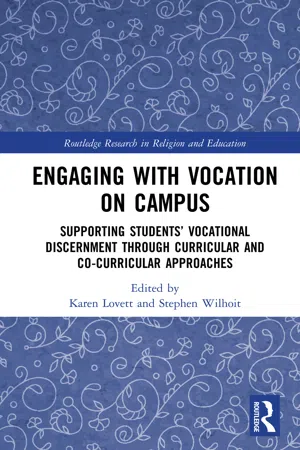
Engaging with Vocation on Campus
Supporting Students' Vocational Discernment through Curricular and Co-Curricular Approaches
- 198 pages
- English
- ePUB (mobile friendly)
- Available on iOS & Android
Engaging with Vocation on Campus
Supporting Students' Vocational Discernment through Curricular and Co-Curricular Approaches
About this book
Bringing together narratives and theory-based analyses of practice, this volume illustrates collaborative curricular and co-curricular approaches to promoting vocational discernment amongst students in a Catholic university setting.
Drawing on cultural, religious, and secular understandings of vocation, Engaging with Vocation on Campus illustrates how contemporary issues around vocation, work, and careers can be addressed within the Catholic intellectual and spiritual tradition. Chapters presents a range of contributions from students, faculty, and staff from a single institution to highlight practical approaches to supporting students in this area, and acknowledge the complementary and intersecting roles played by student support services, academic staff, and on-campus ministry in helping students develop an individualised understanding of vocation. Considering the value of both curricular or non-curricular activities and processes, the volume highlights spiritual, personal, and community value in offering students explicit and tailored support.
This text will benefit researchers, academics, and educators with an interest in higher education, religious education, and the Christian life and experience more broadly. Those specifically interested in career guidance, theological curriculum and pedagogy, and Roman Catholicism will also benefit from this book.
Frequently asked questions
- Essential is ideal for learners and professionals who enjoy exploring a wide range of subjects. Access the Essential Library with 800,000+ trusted titles and best-sellers across business, personal growth, and the humanities. Includes unlimited reading time and Standard Read Aloud voice.
- Complete: Perfect for advanced learners and researchers needing full, unrestricted access. Unlock 1.4M+ books across hundreds of subjects, including academic and specialized titles. The Complete Plan also includes advanced features like Premium Read Aloud and Research Assistant.
Please note we cannot support devices running on iOS 13 and Android 7 or earlier. Learn more about using the app.
Information
1 IntroductionAn institution-wide commitment to vocation in the Catholic intellectual tradition
Education in the Catholic and Marianist traditions strives to support academically students’ efforts to find and explore the deep purposes that lend meaning, wonder, and fulfillment to their lives. These purposes consist not merely in what students may find themselves especially fit for pursuing but in what each student is specially called to do. The university’s commitment to support students’ discernment of their vocations in academically appropriate ways follows from the fundamental objective to educate whole persons, in mind, spirit, and body, for whole lives.(Habits of Inquiry and Reflection, 2006, p. 6)
Answering a call to discover one’s unique gifts and employ them in service for the common good in ways that are personally satisfying and bring meaning to one’s life.(“The Vocation Learning Outcomes at the University of Dayton”)
At a Catholic university, the fundamental questions of Who am I? Whose am I? Why am I here? and, Where am I going? are of critical importance. The Catholic tradition continually raises the question “How shall we live?” as human persons with intellectual, emotional, communal, moral, and spiritual needs and desires.(p. 210)
- a call is an insight to take a particular action or adopt a particular path in life
- a call’s source may be external – a summons from God discovered in faith and community – or internal – a sense of purpose or direction that arises organically from within – or some combination of the two
- a person may come to realize his or her vocation instantaneously or slowly over time
- vocations change, and at any point in a person’s life, he or she is likely pursuing multiple callings
- vocation assumes that every individual has unique gifts to share with others, a combination of skills, talents, knowledge, interests, and experience no one else possesses
- in college, students may be preparing themselves for a vocation they will pursue later in life (entering the pre-med program, for example) while at the same time discovering talents and interests they didn’t know they had (skill as a painter or public speaker, for example)
- acting on one’s vocation brings joy and a sense of personal fulfillment
- by pursuing their vocations, people define their life’s purpose
- vocation is formed and pursued in community, recognizing and acting on one’s responsibility to assist and form mutually supportive bonds with others in pursuit of the common good (“The Vocation Learning Outcomes at the University of Dayton” 2016).
- hosting workshops where faculty and staff could respond to the revised definition of vocation and identify ways it might inform their work with students
- bringing speakers to campus to discuss vocation and vocational discernment
- offering retreats where faculty and staff can reflect on their own callings and vocational journeys
- leading book reading groups focusing on vocation
- Vocation should be integrated into both the curriculum and the co-curriculum.
- Efforts to address vocation must include the work of faculty and staff.
- Addressing vocation successfully requires creativity, innovation, and flexibility.
- Unite faculty and staff initiatives around a ...
Table of contents
- Cover
- Half-Title
- Series
- Title
- Copyright
- Contents
- List of figures
- List of tables
- About the Editors
- List of contributors
- Foreword
- Acknowledgments
- 1 Introduction: An institution-wide commitment to vocation in the Catholic intellectual tradition
- PART 1 Transdisciplinary, purpose-based, and community-engaged approaches to vocation
- PART 2 Discovering the call to learn, lead, and serve through experiential learning
- PART 3 Educators exploring their own callings and building supportive environments for vocation
- PART 4 Dialogue, community-building, and the role of peer leaders in vocation education
- PART 5 The value of vocational discernment in career exploration
- Index